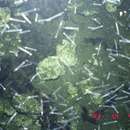en
names in breadcrumbs


Chaetognaths are an important food source for many fishes, squids, and other marine planktivores (Margulis and Chapman 2010). They are themselves predatory on a variety of other animals, including planktonic crustaceans (especially copepods), small fishes, and even other other chaetognaths (Brusca and Brusca 2003; Margulis and Chapman 2010).
Benthic (bottom-dwelling) chaetognaths such as Spadella are ambush predators. They affix themselves to a substrate using adhesive secretions, raise the head, and protrude the mouth, flaring the spines around the mouth. Potential prey swimming nearby are detected (probably by vibration receptors) and then captured by a rapid movement of the head while the rest of the body remains attached to the substratum. The spines grasp and manipulate the prey, which is swallowed whole. (Brusca and Brusca 2003)
Planktonic chaetognaths dart forward to grab prey with their grasping spines. Many, perhaps most, species inject their prey with a potent neurotoxin and studies have suggested that this toxin is synthesized by a commensal Vibrio bacterium inhabiting the chaetognath's head or gut region. Some large Sagitta chaetognaths can capture and consume fishes as large as themselves. (Brusca and Brusca 2003)
Given its ecological importance, the phylum Chaetognatha is surprisingly poorly known. Chaetognaths (commonly known as "arrow worms") are marine predators that typically locate their prey by detecting vibrations produced by copepods and other zooplankton, then use sharp hooks and teeth at the front of the body to grab their victims and immobilize them with neurotoxins. Chaetognaths, most of which are distinctly transparent, are important predators in many marine food webs. Around 120 to 125 species of chaetognaths are known. Most are planktonic, but a small number of species are benthic or live just above the ocean floor. Although species diversity is low, chaetognaths can be very abundant, sometimes dominating the biomass in mid-water plankton sampling tows. Many chaetognaths undergo daily vertical migrations, rising to surface waters at night and sinking downward during the day, possibly to avoid predators. These vertical movements are facilitated by ammonia-filled vacuolated cells in the trunk, which regulate buoyancy. (Brusca and Brusca 2003; Margulis and Chapman 2010; Jennings et al. 2010) At least one chaetognath species (the cosmopolitan Caecosagitta macrocephala, which is generally found below 700 meters) is bioluminescent (Haddock and Case 1994).
Development of chaetognaths is direct, with no larval stage or metamorphosis. Embryo development from zygote (fertilized egg) stage to hatching as a juvenile is about 48 hours. (Brusca and Brusca 2003)
Chaetognaths may occur in large numbers in polar waters, tropical lagoons, and the deep sea. Although most species are planktonic, about a fifth are benthic (bottom-dwelling). (Margulis and Chapman 2010).
Jennings et al. (2010) used mitochondrial cytochrome oxidase I (COI) DNA sequences to examine the correspondence between species delineations based on often very difficult morphological characters and those suggested by COI. They analyzed 52 specimens of 14 nominal species, collected mainly from the Atlantic Ocean. COI was highly successful at discriminating described species of chaetognaths across the phylum (i.e., sequences clustered by species in all cases). The authors note that additional geographic sampling could help clarify the complex biogeographic history of chaetognaths. Many putative species have nearly global distributions, spanning the same latitudinal bands in all ocean basins, while others present disjunct ranges, in some cases with the same species apparently found at both poles. (Jennings et al. 2010).
Chaetognaths lack circulatory, respiratory, and excretory organs. Cilia circulate fluid within each of the three body cavities, transporting nutrients and dissolved waste. Oxygen and carbon dioxide diffuse directly across the body wall. (Margulis and Chapman 2010)
Chaetognaths are hermaphrodites and reproduce sexually. Sperm in the tail cavity mature before the eggs in the trunk cavity. Sperm are released outside the body and cross-fertilization between individuals is typical, although some species may self-fertilize. Fertilization is internal and depending on the species fertilized eggs may be brooded, deposited on the seafloor, or released into the ocean. Embryos undergo direct development, i.e., they develop into tiny adults, with no larval stage. (Margulis and Chapman 2010).
Chaetognaths range in size from 1 mm to 15 cm (Margulis and Chapman 2009).
The phylogenetic placement of the phylum Chaetognatha with respect to other animal phyla has been a subject of longstanding controversy and this controversy has continued in the era of modern methods of phylogenetic analysis using molecular markers (e.g., Paps et al. 2009 and references therein; Jennings et al. 2010 and references therein). As of 2010, evidence seems to indicate that the Chaetognatha are in the superclade Ecdysozoa, along with the arthropods, nematodes, and several smaller phyla.